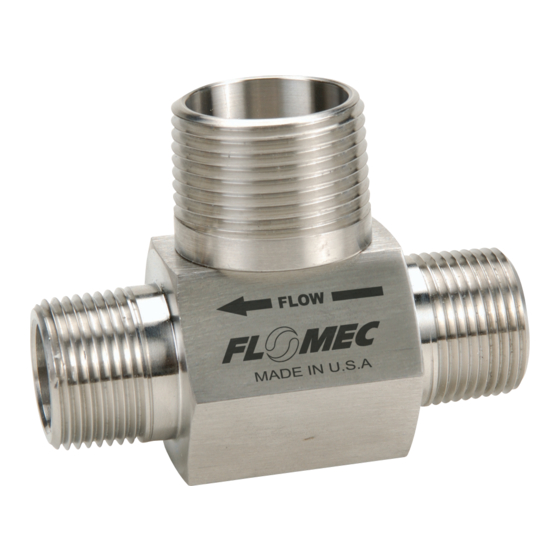Flomec G Series Manuale d'uso del prodotto - Pagina 13
Sfoglia online o scarica il pdf Manuale d'uso del prodotto per Strumenti di misura Flomec G Series. Flomec G Series 20. Industrial and chemical models
Anche per Flomec G Series: Manuale d'uso (16 pagine), Manuale d'uso del prodotto (20 pagine)

Visually inspect the internals of the turbine flowmeter. Check for particulates and/or
foreign objects, which may have lodged between the rotor and the body. In the
event an object is detected, simply remove the retaining ring on the outlet side of
the turbine flowmeter and remove the support and rotor assembly. Once the
turbine flowmeter parts are free from any foreign matter, reassemble.
NOTE: Always ensure that a support vane is installed between the indention marks
on the body.
Upon completion, verify the rotor spins freely, reinstall the turbine flowmeter into
the process line.
If there are no signs of particulates or any other foreign matter obstructing the rotor,
try blowing into the turbine flowmeter. If the rotor does not spin freely, insert a thin
screwdriver or similar tool, gently so as not to damage any of the rotor blades, and
turn the rotor.
There may be another cause for the rotor to drag or stop, such as incorrect bearing
material used for the application. For example, non-compatibility of the bearing
material with the process liquid, bearing material may not withstand the
temperature of the application, etc. When there is uncertainty with respect to the
selection of bearing material for a given application, contact GPI.
Before installing a new replacement kit, inspect the turbine flowmeter body for wear
and damage. By placing your finger inside the turbine flowmeter body, feel for any
signs of wear such as grooves, ridges, irregular spots. If such signs are evident, it
is a strong possibility that the turbine flowmeter body is damaged and the
installation of a new replacement kit is NOT recommended.
When a new replacement kit is installed inside a damaged turbine flowmeter body,
the internals will be ruined after a short period of operation and will have to be
discarded. In the event it is uncertain whether the turbine flowmeter body is
functional, it should be sent to GPI so the I.D. dimension of the turbine flowmeter
body bore can be checked. If it is found to be within tolerance, a new set of internals
will be installed. This will eliminate the possibility of using and/or discarding a
turbine flowmeter that shows signs of wear.
NOTE: A good turbine flowmeter body should have a smooth inner bore free of
wear signs.
If it is determined that the turbine flowmeter body is in good condition, install a
new replacement kit and reinstall the turbine flowmeter into the process line.
Checking the Cable Assembly
This can be accomplished with the aid of a frequency oscillator. Simply plug the
cable assembly with the mating connector end that is located at the turbine
flowmeter into the frequency oscillator. The frequency oscillator will simulate the
output of a turbine flowmeter. If an output is displayed on the electronic readout
device, then the cable assembly is good.
In the event an output is not displayed, disconnect the frequency oscillator from
the cable assembly and connect the cable supplied with the frequency oscillator
directly to the electronic readout device, the same as you would a turbine
flowmeter cable assembly. (Refer to Figure 8.)
13
